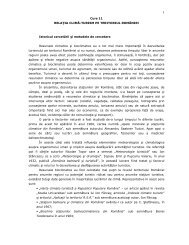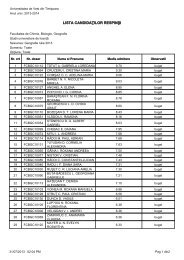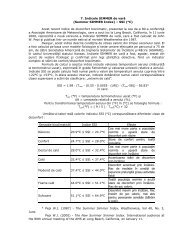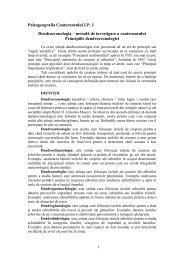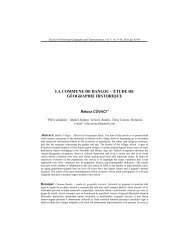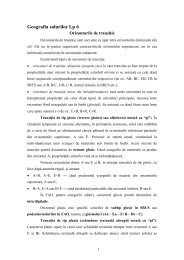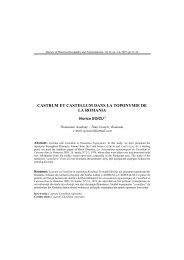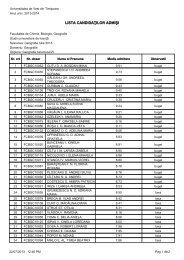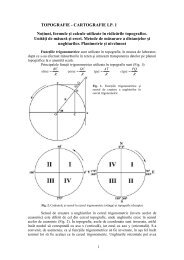the lack of interpretation at fortresses along the danube in serbia
the lack of interpretation at fortresses along the danube in serbia
the lack of interpretation at fortresses along the danube in serbia
You also want an ePaper? Increase the reach of your titles
YUMPU automatically turns print PDFs into web optimized ePapers that Google loves.
190 ● The Lack <strong>of</strong> Interpret<strong>at</strong>ion <strong>at</strong> Fortresses <strong>along</strong> <strong>the</strong> Danube <strong>in</strong> SerbiaTurkish <strong>at</strong>tacks. When <strong>the</strong> Turks conquered it <strong>in</strong> 1459 it was <strong>the</strong> end <strong>of</strong> Serbian medievalst<strong>at</strong>e. Smederevo became <strong>the</strong> capital <strong>of</strong> Smederevo Sandzak, an important str<strong>at</strong>egicstronghold and a trade center. The Danube, <strong>the</strong> Jezava and Petijevski brook gave <strong>the</strong>Fortress its triangular shape divid<strong>in</strong>g it <strong>in</strong>to two parts <strong>the</strong> Small Town and <strong>the</strong> Big Town.Small Town is a specially fortified ruler's court surrounded by w<strong>at</strong>er whilst <strong>in</strong> <strong>the</strong> Big Town<strong>the</strong>re is a complex which consists <strong>of</strong> Archbishop's residence and residential area. TheFortress <strong>of</strong> Smederevo is an <strong>in</strong>terest<strong>in</strong>g place and for its history and architecture def<strong>in</strong>itelyworth visit<strong>in</strong>g.Ram fortress was built on <strong>the</strong> found<strong>at</strong>ions from Roman and Byzantium period. Thefortress has <strong>the</strong> shape <strong>of</strong> an irregular polygon with three closed and one open tower. It wasbuilt by Turkish sultan Bajazit II <strong>in</strong> 1483. It is situ<strong>at</strong>ed between Smederevo and VelikoGradiste. With<strong>in</strong> <strong>the</strong> fortific<strong>at</strong>ion <strong>the</strong>re are rema<strong>in</strong>s <strong>of</strong> Turkish church and old caravansary, 6centuries old. Ram fortress is one <strong>of</strong> <strong>the</strong> best examples <strong>of</strong> military architecture from Turkishperiod. Today it is <strong>in</strong> ru<strong>in</strong>s, and opened for occasional visitors. There are some plans for itsrestor<strong>at</strong>ion and tourism development, but <strong>the</strong>y are still wait<strong>in</strong>g don<strong>at</strong>ions.Golubac fortress is a monumental medieval fortress on <strong>the</strong> bank <strong>of</strong> Danube, <strong>at</strong> <strong>the</strong>entrance to Iron G<strong>at</strong>e. Golubac is a town <strong>of</strong> gre<strong>at</strong> architecture where its rich cultural,centuries long heritage is present <strong>in</strong> each corner, wall or its tower. This medieval fortress issitu<strong>at</strong>ed <strong>in</strong> N<strong>at</strong>ional park Djerdap on <strong>the</strong> high cliffs <strong>at</strong> <strong>the</strong> place where <strong>the</strong> Danube narrows.The first written documents about <strong>the</strong> Fortress d<strong>at</strong>e from <strong>the</strong> war between Serbian emperorDusan and Hungarian k<strong>in</strong>g Robert <strong>of</strong> Anjou, around 1335. Golubac had been a refuge <strong>of</strong>Hungarian rulers for a long time, but it <strong>of</strong>ten <strong>at</strong>tracted Serbian and l<strong>at</strong>er Turkish conquerors.Golubac was under Turkish rule from 1427 until 1867, when it was abandoned. It is<strong>at</strong>tractive, but only as a landscape, as it is very dangerous to climb to <strong>the</strong> fortress. It is notused for touristic purposes, even though it has enormous potential.Kladovo fortress (Fetislam) fortific<strong>at</strong>ion is situ<strong>at</strong>ed several kilometers upstreamfrom Kladovo on <strong>the</strong> bank <strong>of</strong> river Danube. The Smaller town was erected around 1524 as astart<strong>in</strong>g po<strong>in</strong>t <strong>of</strong> Turkish assaults on Erdelj. Dur<strong>in</strong>g <strong>the</strong> Austro-Turkish conflicts from 1717to 1739 <strong>the</strong> Smaller Town acquires str<strong>at</strong>egic importance, thus <strong>the</strong> Gre<strong>at</strong>er Town is erectedaround it. After <strong>the</strong> last reconstruction Fetislam is turned <strong>in</strong>to a artillery bastion. With <strong>the</strong>erection <strong>of</strong> Fetislam <strong>the</strong> Turkish defense l<strong>in</strong>e towards Hungary was completed and this l<strong>in</strong>ewas made <strong>of</strong> <strong>fortresses</strong> <strong>in</strong> Smederevo, Kulic, Ram, Golubac and Fetislam. The Turkishgarrison stayed up to 1867 when toge<strong>the</strong>r with six o<strong>the</strong>r fortified towns was handed over to<strong>the</strong> Serbian pr<strong>in</strong>ce Mihajlo. Today <strong>the</strong>re are only <strong>the</strong> rema<strong>in</strong>s <strong>of</strong> this fortress, mostly badlyma<strong>in</strong>ta<strong>in</strong>ed. (Stanojlović, 2009)Danubian <strong>fortresses</strong> <strong>in</strong> Serbia are ma<strong>in</strong>ta<strong>in</strong>ed by regional <strong>in</strong>stitutional departmentsfor protection <strong>of</strong> cultural monuments, under <strong>the</strong> M<strong>in</strong>istry <strong>of</strong> Culture, which renov<strong>at</strong>es,promotes and ma<strong>in</strong>ta<strong>in</strong>s <strong>the</strong> sites. Beside renov<strong>at</strong>ion and upkeep <strong>of</strong> <strong>the</strong> <strong>fortresses</strong>, it is <strong>the</strong>task <strong>of</strong> <strong>the</strong> govern<strong>in</strong>g body to promote <strong>fortresses</strong> and safeguard its <strong>at</strong>mosphere andconstructions for future gener<strong>at</strong>ions. The Serbian tourist organiz<strong>at</strong>ion, and local tourism<strong>of</strong>fices additionally give support, assist<strong>in</strong>g <strong>in</strong> market<strong>in</strong>g and tourism development. At <strong>the</strong>moment, none <strong>of</strong> <strong>the</strong> Danubian <strong>fortresses</strong> are on <strong>the</strong> World Heritage Site List, even though<strong>the</strong> UNESCO gave a support to <strong>the</strong> cre<strong>at</strong>ion <strong>of</strong> cultural route “Fortresses on Danube” <strong>in</strong>2009. Throughout <strong>the</strong> history a mixture <strong>of</strong> Serbian, Turkish, Hungarian and Austrian<strong>in</strong>fluences had a pr<strong>of</strong>ound <strong>in</strong>fluence on <strong>the</strong> development <strong>of</strong> forts, <strong>the</strong> region and Serbia aswhole. Even though <strong>the</strong>se <strong>fortresses</strong> no longer have <strong>the</strong>ir military significance, <strong>the</strong>y serve as
Aleksandra STANOJLOVIC, Andjelija IVKOV-DZIGURSKI, Aleksandra DRAGIN ● 191a recre<strong>at</strong>ional areas and some <strong>of</strong> <strong>the</strong>m are tourist <strong>at</strong>tractions. All <strong>of</strong> <strong>the</strong>se seven sites kept<strong>the</strong>ir orig<strong>in</strong>al character as constructions <strong>of</strong> military architecture. Beside <strong>the</strong> local communityservices, several restaurants, cafés and museums can be found with<strong>in</strong> those sites. On somesites (Petrovarad<strong>in</strong>, Belgrade and Smederevo fortress) <strong>in</strong>form<strong>at</strong>ion desks are opened, giv<strong>in</strong>gvisitors a chance to learn about history <strong>of</strong> <strong>the</strong> fortress. All <strong>the</strong> <strong>fortresses</strong> on Danube, areopen <strong>the</strong> whole year for tourists, even though it is very dangerous to climb some <strong>of</strong> <strong>the</strong>mbecause <strong>of</strong> litter and poor shape <strong>of</strong> <strong>in</strong>frastructure. Some <strong>fortresses</strong> as those loc<strong>at</strong>ed <strong>in</strong>Belgrade, Petrovarad<strong>in</strong> and Smederevo <strong>at</strong>tract thousands <strong>of</strong> visitors from all ages and socialgroups with <strong>the</strong>ir culture, n<strong>at</strong>ure and events. A huge part <strong>of</strong> <strong>the</strong> visitors are made up by <strong>the</strong>local residents and Serbian visitors on educ<strong>at</strong>ional excursion trips, as well as <strong>in</strong>tern<strong>at</strong>ionaltourists, com<strong>in</strong>g to on a outdoor day recre<strong>at</strong>ion or visit<strong>in</strong>g <strong>the</strong> museums, exhibitions andevents. On <strong>the</strong> o<strong>the</strong>r hand, some <strong>fortresses</strong> on Danube are hardly visited <strong>at</strong> all, like Golubac,Ram and Fetislam. In order to develop tourism and enlarge touristic visit<strong>at</strong>ion on <strong>the</strong>se sites,<strong>the</strong> management <strong>of</strong> <strong>the</strong> site demands cont<strong>in</strong>uous improvements on all <strong>of</strong> <strong>the</strong>se <strong>fortresses</strong>.The elementary touristic <strong>in</strong>frastructure is needed on several loc<strong>at</strong>ions – especially on LowerDanube region – Ram, Golubac and Kladovo fortress, and some m<strong>in</strong>or improvements on<strong>fortresses</strong> <strong>in</strong> Bac, Petrovarad<strong>in</strong>, Belgrade and Smederevo. It is essential to improve <strong>the</strong>services <strong>in</strong> transport<strong>at</strong>ion, <strong><strong>in</strong>terpret<strong>at</strong>ion</strong> and sign-post<strong>in</strong>g.4. SWOT ANALYSISUsually SWOT is known <strong>in</strong> rel<strong>at</strong>ion with market research and market<strong>in</strong>g plann<strong>in</strong>g. Itmeans an analysis <strong>of</strong> <strong>the</strong> bus<strong>in</strong>ess environment, apprais<strong>in</strong>g <strong>the</strong> current market situ<strong>at</strong>ion andidentify<strong>in</strong>g problems to determ<strong>in</strong>e objectives for <strong>the</strong> near future. Strengths and weaknessesare identified and any opportunities and thre<strong>at</strong>s fac<strong>in</strong>g a heritage asset is determ<strong>in</strong>ed as abasis for fur<strong>the</strong>r action taken. In fact, it is a conceptual present<strong>at</strong>ion <strong>of</strong> d<strong>at</strong>a collected fromboth, external and <strong>in</strong>ternal analysis. Carry<strong>in</strong>g out an analysis us<strong>in</strong>g <strong>the</strong> SWOT frameworkhelps to focus activities <strong>in</strong>to areas th<strong>at</strong> are strong, and where <strong>the</strong> gre<strong>at</strong>est opportunities lie.To be able to give a <strong>in</strong>-depth analysis <strong>of</strong> <strong>the</strong> strengths, weaknesses, opportunities and thre<strong>at</strong>s<strong>in</strong> rel<strong>at</strong>ion to tourism development it appears necessary to get <strong>in</strong>to <strong>the</strong> field <strong>in</strong> order toobta<strong>in</strong> knowledge about <strong>the</strong> management <strong>of</strong> particular heritage sites. In this way, substantial<strong>in</strong>form<strong>at</strong>ion on <strong>the</strong> site’s unique strengths can be identified and possible weaknessesrecognized. A comprehensive analysis <strong>of</strong> <strong>the</strong>se elements helps to determ<strong>in</strong>e <strong>the</strong> steps to betaken <strong>in</strong> order to build on <strong>the</strong> strengths, correct areas <strong>of</strong> weakness, highlight advantages <strong>of</strong>opportunities and figure out plans to counter possible thre<strong>at</strong>s <strong>at</strong> each site. As all <strong>fortresses</strong><strong>along</strong> <strong>the</strong> Danube corridor <strong>in</strong> Serbia are predicted for tourism development, <strong>the</strong> SWOTanalysis will be conducted to po<strong>in</strong>t out <strong>the</strong> <strong>lack</strong><strong>in</strong>g elements, <strong>in</strong> order to obta<strong>in</strong> certa<strong>in</strong>necessarily elements for tourism affirm<strong>at</strong>ion. In this case <strong>the</strong> SWOT analysis is conductedon <strong>the</strong> basis on whole Cultural route-Fortresses on Danube <strong>in</strong> Serbia.• Strengths should be seen from <strong>the</strong> perspective <strong>of</strong> <strong>the</strong> customer and from <strong>the</strong>management perspective as <strong>the</strong>y comprise <strong>the</strong> fe<strong>at</strong>ures <strong>of</strong> <strong>the</strong> heritage site th<strong>at</strong> have specialquality, are unique and strong. They are <strong>the</strong> fe<strong>at</strong>ures th<strong>at</strong> <strong>in</strong> general differenti<strong>at</strong>e from <strong>the</strong>competition and are particularly <strong>at</strong>tractive for <strong>the</strong> visitors.• Weaknesses represent those fe<strong>at</strong>ures <strong>of</strong> <strong>the</strong> heritage site th<strong>at</strong> are especially weakcompared with <strong>the</strong> competition and <strong>the</strong>refore would require improvement.
192 ● The Lack <strong>of</strong> Interpret<strong>at</strong>ion <strong>at</strong> Fortresses <strong>along</strong> <strong>the</strong> Danube <strong>in</strong> Serbia•Opportunities stand for favorable circumstances and <strong>in</strong>terest<strong>in</strong>g trends to exploit anyparticular strengths and potential for future development.•Thre<strong>at</strong>s are almost always external fe<strong>at</strong>ures and can pose major problems and majoreffect on <strong>the</strong> future <strong>of</strong> a site. It is important to anticip<strong>at</strong>e <strong>the</strong>se thre<strong>at</strong>s and try to m<strong>in</strong>imize orneg<strong>at</strong>e <strong>the</strong>m.Table 2. SWOT analysis <strong>of</strong> <strong>fortresses</strong> <strong>along</strong> <strong>the</strong> Danube <strong>in</strong> SerbiaStre<strong>in</strong>ghtsHistory, Heritage, Culture and ArtsN<strong>at</strong>ure and idyllic milieuAvailable all year roundVariety <strong>of</strong> events through <strong>the</strong> yearHospitality facilities (restaurants, shops...)Day-trip dest<strong>in</strong><strong>at</strong>ion for outdoor activitiesOpportunitiesPotential <strong>of</strong> cultural route cre<strong>at</strong>ionDevelopment <strong>of</strong> new services (visitorcentres, bike rent<strong>in</strong>g, souvenir shops, etc)Interpret<strong>at</strong>ion, visitor educ<strong>at</strong>ion, anim<strong>at</strong>ionand eventsEmphasiz<strong>in</strong>g and improv<strong>in</strong>g tourist servicesDeveloped management and market<strong>in</strong>gsystemProvision <strong>of</strong> accommod<strong>at</strong>ion, <strong>in</strong>ternaltransport<strong>at</strong>ion, museum and event activitiesWeaknessesIntern<strong>at</strong>ionally unknown as a heritage sitesBad quality <strong>of</strong> <strong>in</strong>frastructure and access p<strong>at</strong>hsAccess mostly by foot and long walk<strong>in</strong>gdistancesLimited availability to some <strong>at</strong>tractive assetsNon-exsistence <strong>of</strong> visitor centresLack <strong>of</strong> <strong><strong>in</strong>terpret<strong>at</strong>ion</strong> and <strong>in</strong>form<strong>at</strong>ionLack <strong>of</strong> accommod<strong>at</strong>ion facilities andtransport<strong>at</strong>ion systemMostly recre<strong>at</strong>ion and event oriented visitorsra<strong>the</strong>r than culture orientedThre<strong>at</strong>sLack <strong>of</strong> ma<strong>in</strong>tenance and conserv<strong>at</strong>ionDegrad<strong>at</strong>ion and litterLack <strong>of</strong> fund<strong>in</strong>gConflicts between residents and touristsImage problems through unfavorablemanagement, market<strong>in</strong>g or behavior <strong>of</strong> event visitorsFrom facts presented <strong>in</strong> Table 1, it seems clear th<strong>at</strong>, <strong>the</strong> strengths for tourismdevelopment <strong>in</strong> Danubian <strong>fortresses</strong> certa<strong>in</strong>ly share many aspects with <strong>the</strong> strengths <strong>of</strong> o<strong>the</strong>rheritage sites or <strong>at</strong>tractions with similar characteristics. Therefore <strong>the</strong> analysis will conf<strong>in</strong>eitself to exam<strong>in</strong>e <strong>the</strong> weaknesses and opportunities more closely. The thre<strong>at</strong>s, <strong>in</strong> turn, can beconsidered as consequences <strong>of</strong> ignored or <strong>in</strong>adequ<strong>at</strong>ely managed weaknesses and missedopportunities. As <strong>the</strong> core <strong>of</strong> this research comprises <strong><strong>in</strong>terpret<strong>at</strong>ion</strong> and visitor educ<strong>at</strong>ion,<strong>the</strong>se will be <strong>the</strong> areas specifically focused on, when look<strong>in</strong>g deeper <strong>in</strong>to <strong>the</strong> SWOT analysis<strong>of</strong> <strong>fortresses</strong>. The first th<strong>in</strong>g to po<strong>in</strong>t out is th<strong>at</strong> those sites face is a gre<strong>at</strong> problem withdegrad<strong>at</strong>ion. The most widely reported risk to archaeological type <strong>of</strong> heritage, such as<strong>fortresses</strong>, is <strong>the</strong> <strong>lack</strong> <strong>of</strong> ma<strong>in</strong>tenance and conserv<strong>at</strong>ion <strong>of</strong> rema<strong>in</strong>s. Damage toarchaeological heritage is almost certa<strong>in</strong> when excav<strong>at</strong>ed cultural fe<strong>at</strong>ures are left exposedwithout any management plan or resources for <strong>the</strong>ir protection, conserv<strong>at</strong>ion ormanagement. The impacts range from physical deterior<strong>at</strong>ion - such as <strong>the</strong> crack<strong>in</strong>g andspall<strong>in</strong>g <strong>of</strong> monumental stone structures, and <strong>the</strong> wea<strong>the</strong>r<strong>in</strong>g and crumbl<strong>in</strong>g <strong>of</strong> mudbrickfe<strong>at</strong>ures - to <strong>the</strong> erosion and slump<strong>in</strong>g <strong>of</strong> excav<strong>at</strong>ed cultural layers, as well as vandalism and
Aleksandra STANOJLOVIC, Andjelija IVKOV-DZIGURSKI, Aleksandra DRAGIN ● 193loot<strong>in</strong>g. It should also be mentioned th<strong>at</strong> certa<strong>in</strong> archaeological heritage sites are <strong>at</strong> riskbecause <strong>the</strong>y are not valued as much as o<strong>the</strong>r heritage sites. Risks <strong>in</strong>clude a lower level orno st<strong>at</strong>utory protection, or limited resources for protection, management and conserv<strong>at</strong>ion,because th<strong>at</strong> country alloc<strong>at</strong>es gre<strong>at</strong>er st<strong>at</strong>us and protection to monumental archaeologicalheritage than less visible and less impos<strong>in</strong>g archaeological fe<strong>at</strong>ures. O<strong>the</strong>r problem isseasonality <strong>of</strong> visits. While <strong>the</strong> w<strong>in</strong>ter season is extremely quiet and almost all <strong>the</strong> servicesonly have restricted availability, <strong>the</strong> fortress are flooded with visitors <strong>in</strong> <strong>the</strong> spr<strong>in</strong>g andsummer season. Moreover, due to <strong>the</strong> vic<strong>in</strong>ity <strong>of</strong> hordes <strong>of</strong> residents <strong>in</strong> everyday life arepulled <strong>in</strong>. Toge<strong>the</strong>r with <strong>the</strong> fact th<strong>at</strong> <strong>the</strong>re appears to be a <strong>lack</strong> <strong>of</strong> <strong><strong>in</strong>terpret<strong>at</strong>ion</strong> andexplan<strong>at</strong>ory sign-post<strong>in</strong>g, this <strong>in</strong>dic<strong>at</strong>es th<strong>at</strong> <strong>the</strong>re are extensive impacts on <strong>the</strong> environment(n<strong>at</strong>ural and cultural) <strong>in</strong> th<strong>at</strong> time. The seasonality could be partly addressed through <strong>the</strong>organiz<strong>at</strong>ion <strong>of</strong> several cultural events <strong>in</strong> <strong>the</strong> low season to shift <strong>the</strong> amount <strong>of</strong> visitors. Eventhough most <strong>of</strong> <strong>the</strong> mentioned <strong>fortresses</strong> not have large scale touristic visit<strong>at</strong>ion, certa<strong>in</strong>levels <strong>of</strong> degrad<strong>at</strong>ion through visitor impacts can be found. For <strong>the</strong> visitors <strong>the</strong> various longtermdamages result<strong>in</strong>g from tourism do not necessarily become obvious, which mayexpla<strong>in</strong> <strong>the</strong> <strong>lack</strong> <strong>of</strong> concern and <strong>the</strong> ignorance <strong>in</strong> <strong>the</strong>ir behavior <strong>in</strong> many respects. On <strong>the</strong>subject <strong>of</strong> <strong>in</strong>sufficient amount <strong>of</strong> free promotional m<strong>at</strong>erial, <strong>in</strong>form<strong>at</strong>ion and market<strong>in</strong>g <strong>of</strong><strong>fortresses</strong> as valuable heritage sites, it can be st<strong>at</strong>ed th<strong>at</strong> this goes hand <strong>in</strong> hand with<strong><strong>in</strong>terpret<strong>at</strong>ion</strong>. The process <strong>of</strong> <strong><strong>in</strong>terpret<strong>at</strong>ion</strong> for <strong>the</strong> visitor beg<strong>in</strong>s <strong>in</strong> <strong>the</strong> promotionalactivity, as <strong>the</strong> brochures obta<strong>in</strong>ed <strong>of</strong>f-site set a certa<strong>in</strong> scene <strong>in</strong> <strong>the</strong> m<strong>in</strong>d <strong>of</strong> <strong>the</strong> visitors.Provid<strong>in</strong>g good <strong>in</strong>form<strong>at</strong>ion for visitors may encourage a m<strong>at</strong>ch between visitor wants and<strong>the</strong> benefits <strong>fortresses</strong> can <strong>of</strong>fer. The <strong>at</strong>tractiveness <strong>of</strong> Danubian <strong>fortresses</strong> and <strong>the</strong>sensitiveness <strong>of</strong> <strong>the</strong> sites as heritage assets demand changes <strong>in</strong> <strong>the</strong> management towardsmore responsibility and concern.5. INTERPRETATION ON DANUBIAN FORTRESSES IN SERBIAFrom all <strong>the</strong> different tourist facilities, only those th<strong>at</strong> were accessible <strong>at</strong> <strong>the</strong> time and<strong>the</strong>refore could be observed <strong>in</strong> terms <strong>of</strong> <strong><strong>in</strong>terpret<strong>at</strong>ion</strong> and visitor anim<strong>at</strong>ion, were <strong>in</strong>cluded<strong>in</strong> <strong>the</strong> research and r<strong>at</strong>ed accord<strong>in</strong>g to different levels and extend <strong>of</strong> <strong><strong>in</strong>terpret<strong>at</strong>ion</strong>. Thisframework model provides an effective tool to consider <strong>the</strong> extent <strong>of</strong> <strong><strong>in</strong>terpret<strong>at</strong>ion</strong> <strong>in</strong>heritage sites, def<strong>in</strong>ed <strong>in</strong> terms <strong>of</strong> <strong>the</strong> level <strong>of</strong> <strong><strong>in</strong>terpret<strong>at</strong>ion</strong> th<strong>at</strong> <strong>the</strong> several facilities with<strong>in</strong><strong>fortresses</strong> exhibit.The criteria used for analysis was as follows:- No-<strong><strong>in</strong>terpret<strong>at</strong>ion</strong> - basic <strong>in</strong>form<strong>at</strong>ion about fortress as heritage sites are notavailable.- Simple <strong><strong>in</strong>terpret<strong>at</strong>ion</strong> - <strong>the</strong> basic <strong>in</strong>form<strong>at</strong>ion (maps, signs, brochures) and someservices (guided- tours, electronic displays, special exhibitions and o<strong>the</strong>r <strong>in</strong>terpret<strong>at</strong>ive toolsto give detailed explan<strong>at</strong>ion to visitors) are available.Sophistic<strong>at</strong>ed <strong><strong>in</strong>terpret<strong>at</strong>ion</strong> - use <strong>of</strong> all tools and <strong>the</strong>ir <strong>in</strong>tegr<strong>at</strong>ion <strong>in</strong> <strong>the</strong> visitormanagement with <strong>the</strong> aim to foster positive <strong>at</strong>titudes for conserv<strong>at</strong>ion and appreci<strong>at</strong>ion toensure <strong>the</strong> long-term protection <strong>of</strong> <strong>the</strong> site as well as cont<strong>in</strong>ued visitor enjoyment.Observ<strong>in</strong>g <strong>the</strong> Graph 1. it po<strong>in</strong>ts out to <strong>the</strong> fact, th<strong>at</strong> <strong>the</strong>re is very little <strong>in</strong>form<strong>at</strong>ionand poor visitor service <strong>at</strong> <strong>the</strong> most <strong>of</strong> <strong>the</strong> fortress <strong>in</strong> Danube region <strong>in</strong> Serbia. Access tosome <strong>of</strong> <strong>the</strong> places is constantly restricted. It is ra<strong>the</strong>r so, th<strong>at</strong> <strong>in</strong> order to obta<strong>in</strong> m<strong>at</strong>erials or
194 ● The Lack <strong>of</strong> Interpret<strong>at</strong>ion <strong>at</strong> Fortresses <strong>along</strong> <strong>the</strong> Danube <strong>in</strong> Serbia<strong>in</strong>form<strong>at</strong>ion, one has to pay (e.g. entrance fees to museums), a fact th<strong>at</strong> probably makesvisitors reluctant to collect <strong>in</strong>form<strong>at</strong>ion <strong>at</strong> all. It can not be denied th<strong>at</strong> <strong>the</strong> overall extend <strong>of</strong><strong>in</strong>terpret<strong>at</strong>ive <strong>in</strong>form<strong>at</strong>ion is available <strong>in</strong> different extent <strong>at</strong> Danubian <strong>fortresses</strong> <strong>in</strong> Serbia.While <strong>at</strong> Petrovarad<strong>in</strong>, Belgrade and Smederevo fortress, <strong>the</strong>re are museums, <strong>in</strong>fo centers,souvenir shops, restaurants, available tour-guides, present<strong>at</strong>ions, organized events andprogrammes on regular basis, on o<strong>the</strong>r sites (Bac, Ram, Golubac and Kladovo fortress)<strong><strong>in</strong>terpret<strong>at</strong>ion</strong> is kept def<strong>in</strong>itely <strong>at</strong> a m<strong>in</strong>imum. The one and only <strong>in</strong>form<strong>at</strong>ive source with <strong>the</strong>possibility to familiarize oneself with <strong>the</strong> virtues and values <strong>of</strong> fortress and <strong>the</strong>refore <strong>the</strong>reasons for conserv<strong>at</strong>ion, protection and responsible behavior was <strong>the</strong> activities <strong>of</strong> <strong>the</strong>museums. None<strong>the</strong>less it should be noted th<strong>at</strong> <strong>the</strong> terms <strong>of</strong> <strong><strong>in</strong>terpret<strong>at</strong>ion</strong> <strong>at</strong> those facilitiesdo not embrace all tools <strong>at</strong> hand, and to some extent tools are already <strong>in</strong> use. However, <strong>the</strong>development <strong>of</strong> visitor management and educ<strong>at</strong>ion about value and significance <strong>of</strong> <strong>the</strong> siteshas only recently begun to draw serious <strong>at</strong>tention.The facilities r<strong>at</strong>ed on a level <strong>of</strong> simple <strong><strong>in</strong>terpret<strong>at</strong>ion</strong> ma<strong>in</strong>ly <strong>of</strong>fered maps, pla<strong>in</strong>brochures and guided tours, without an addition to some specialty like electronic displays,and are like most <strong>of</strong> <strong>the</strong> museums, specialized on one s<strong>in</strong>gle characteristic <strong>of</strong> fortress, as for<strong>in</strong>stance, military history, archeology or art. The <strong>fortresses</strong> <strong>in</strong> Iron G<strong>at</strong>e region are r<strong>at</strong>ed onno <strong><strong>in</strong>terpret<strong>at</strong>ion</strong> level as <strong>the</strong>y does not <strong>of</strong>fer basic <strong>in</strong>form<strong>at</strong>ion, no maps or pla<strong>in</strong> brochures,as <strong>the</strong>re are no <strong>in</strong>stitutions <strong>of</strong> museum type on those sites. Some <strong>fortresses</strong> even did not haveany k<strong>in</strong>d <strong>of</strong> <strong>in</strong>form<strong>at</strong>ion on site. Beside all <strong>the</strong> different facilities, <strong>the</strong> entire environment <strong>in</strong>terms <strong>of</strong> signposts and explan<strong>at</strong>ory boards <strong>at</strong> places <strong>of</strong> <strong>in</strong>terest would possibly be r<strong>at</strong>ed onhav<strong>in</strong>g no <strong><strong>in</strong>terpret<strong>at</strong>ion</strong>, if to be <strong>in</strong>cluded <strong>in</strong> <strong>the</strong> research. There are some <strong>the</strong>m<strong>at</strong>ic eventsth<strong>at</strong> are organized on <strong>the</strong> <strong>fortresses</strong> reviv<strong>in</strong>g medieval life and tournaments. Those moments<strong>in</strong> <strong>the</strong> contemporary life <strong>of</strong> <strong>fortresses</strong> on Danube are ra<strong>the</strong>r rare and as <strong>the</strong> basic<strong>in</strong>frastructure and <strong><strong>in</strong>terpret<strong>at</strong>ion</strong> are <strong>lack</strong><strong>in</strong>g on several sites, <strong>the</strong> anim<strong>at</strong>ion programmes arenot imag<strong>in</strong>able <strong>at</strong> this moment.CONCLUSIONSFortresses, castles or <strong>the</strong>ir rema<strong>in</strong>s are important part <strong>of</strong> history, significant heritagesites and gre<strong>at</strong> touristic <strong>at</strong>tractions. Every fortress <strong>in</strong> Serbia has its own “soul” to be sensedby those who visit it. Never<strong>the</strong>less, <strong>the</strong>ir history and stories are still untold and <strong>fortresses</strong>abandoned and forgotten. Only occasional visitors have <strong>the</strong> <strong>in</strong>terest to climb dangerouscliffs or steam p<strong>at</strong>hs to Serbian <strong>fortresses</strong>. The conclusion can now be declared – <strong>the</strong><strong>fortresses</strong> on Danube <strong>in</strong> Serbia <strong>lack</strong> <strong>in</strong> <strong>in</strong>frastructure, as gre<strong>at</strong> <strong>in</strong>vestments are needed for itsconstruction. The basic <strong>in</strong>form<strong>at</strong>ion and <strong><strong>in</strong>terpret<strong>at</strong>ion</strong> on <strong>fortresses</strong> is <strong>lack</strong><strong>in</strong>g also – whichis even bigger problem, as it shows <strong>the</strong> recklessness <strong>of</strong> Serbian n<strong>at</strong>ion to its heritage, as thissegment does not necessit<strong>at</strong>es large <strong>in</strong>vestments. The ma<strong>in</strong> reason for nonexistence <strong>of</strong>tourism development <strong>in</strong> Serbian heritage sites is weak local <strong>in</strong>iti<strong>at</strong>ive, non-cre<strong>at</strong>ivity or <strong>lack</strong><strong>of</strong> <strong>in</strong>vestments.First step <strong>in</strong> develop<strong>in</strong>g tourist <strong>of</strong>fer based on <strong>fortresses</strong> <strong>in</strong> Serbia should besignpost<strong>in</strong>g and basic <strong><strong>in</strong>terpret<strong>at</strong>ion</strong> on sites and l<strong>at</strong>er gre<strong>at</strong> reconstructions and<strong>in</strong>frastructure build<strong>in</strong>g. In develop<strong>in</strong>g successful tourism dest<strong>in</strong><strong>at</strong>ion or <strong>at</strong>tractions <strong>the</strong> mostimportant is cre<strong>at</strong>ive th<strong>in</strong>k<strong>in</strong>g, idea and <strong><strong>in</strong>terpret<strong>at</strong>ion</strong>. By us<strong>in</strong>g <strong>the</strong> <strong><strong>in</strong>terpret<strong>at</strong>ion</strong>, <strong>the</strong>m<strong>at</strong>iccultural and anim<strong>at</strong>ion programmes <strong>the</strong> “soul” <strong>of</strong> <strong>the</strong>se magnificent <strong>fortresses</strong> can be
Aleksandra STANOJLOVIC, Andjelija IVKOV-DZIGURSKI, Aleksandra DRAGIN ● 195revived. This is very popular and very successful way <strong>of</strong> <strong>in</strong>corpor<strong>at</strong><strong>in</strong>g heritage site <strong>in</strong>tourism sphere. Every historical site have <strong>the</strong> potential for tourism development, but as suchsites are fragile, <strong>the</strong>y must be used cautiously and substantially. Most important part <strong>of</strong>touristic development <strong>in</strong> Danubian and every o<strong>the</strong>r fortress is <strong>the</strong> adequ<strong>at</strong>e conserv<strong>at</strong>ion,management and <strong><strong>in</strong>terpret<strong>at</strong>ion</strong>. Incorpor<strong>at</strong><strong>in</strong>g <strong>the</strong>se tools <strong>in</strong> <strong>the</strong> development <strong>of</strong> Culturalroute – Fortresses on Danube <strong>in</strong> Serbia, <strong>the</strong>y will most certa<strong>in</strong>ly become more <strong>at</strong>tractive, <strong>the</strong>visit<strong>at</strong>ion will rise, as well as <strong>the</strong> knowledge <strong>of</strong> <strong>the</strong> residents and tourists, and <strong>the</strong>ir mutualunderstand<strong>in</strong>g.ACKNOLEDGEMENTSThis study is a part <strong>of</strong> <strong>the</strong> project “Demographic transition <strong>in</strong> Serbia” (EVB:146017) by M<strong>in</strong>istry <strong>of</strong> Science <strong>of</strong> Republic Serbia, as well as a part <strong>of</strong> doctoral work <strong>of</strong>Aleksandra Stanojlovic. The research is accomplished with <strong>the</strong> support <strong>of</strong> M<strong>in</strong>istry <strong>of</strong>Culture, as well as regional <strong>in</strong>stitutions – Museum <strong>of</strong> Novi Sad, JP Belgrade Fortress,Museum <strong>of</strong> Smederevo, Archaeological Museum <strong>of</strong> Djerdap and Touristic organis<strong>at</strong>ion <strong>of</strong>Golubac.REFERENCESBriedenhann, J. and Wickers, E. (2003) “ Tourism routes as a tool for <strong>the</strong> economicdevelopment <strong>of</strong> rural areas – Vibrant hope or impossible dream”. Tourism management, July issue.Bruce, D. (2006) "Contested identities: The disonant heritage <strong>of</strong> European town walls andwalled towns". Intern<strong>at</strong>ional journal <strong>of</strong> heritage studies, Vol 12. pp 234-254.CIUTAT Project (2005) <strong>in</strong> CIUTAT: Tourism,cultural events and <strong>the</strong> production <strong>of</strong> urbanspace:Chang<strong>in</strong>g images,shift<strong>in</strong>g mean<strong>in</strong>gs? Onl<strong>in</strong>e source: www.ciut<strong>at</strong>project.netChhabra, D., Healy, R. And Sills, E. (2003) Staged au<strong>the</strong>nticity and heritage tourism.Annals <strong>of</strong> Tourism Research 30(3), 702 – 719.Čomić, ð. (2007) Analiza multifaznih turističkih doživljaja. Turizam 11/2007, Časopisdepartmana za geografiju,turizam i hotelijerstvo, Prirodno-m<strong>at</strong>em<strong>at</strong>ički fakultet, Novi Sad, str.7-9.Drag<strong>in</strong>, A. i grupa autora (2007) Cruise Ship Tourism on <strong>the</strong> Danube <strong>in</strong> Vojvod<strong>in</strong>a Prov<strong>in</strong>ceas a Segment <strong>of</strong> Global Tourism, Geogrphica Pannonica, Vol.11, 59–64.Drag<strong>in</strong>, A. (2008) Intern<strong>at</strong>ional tourist cruises <strong>along</strong> Corridor 7 and nautical tourism <strong>in</strong>Serbia, (Phd <strong>the</strong>sis <strong>in</strong> paper), University <strong>of</strong> Noci Sad, Faculty <strong>of</strong> Science, Department for geography,tourism and hotel management, Novi Sad, 228.ðidić, P. (2008) Tvrñave i ostaci utvrñenih gradova, JP Beogradska tvrñava, Beograd.Meyer, D. (2004) Tourism routes and g<strong>at</strong>eways: Examples and a selection <strong>of</strong> key isues fordevelopment <strong>of</strong> tourism routes and g<strong>at</strong>eways and <strong>the</strong>ir potential for pro-poor tourism. Tourism.London: ODI.Puczko, L. (2006) Interpret<strong>at</strong>ion <strong>in</strong> cultural tourism. In Smith, M. & Rob<strong>in</strong>son, M. (ed.)Cultural Tourism <strong>in</strong> a Chang<strong>in</strong>g World: Politics, Particip<strong>at</strong>ion and (re)present<strong>at</strong>ion (Tourism andCultural Change),pp.227 – 244.Puczko, L., R<strong>at</strong>z, T., Smith, M. (2007) Old City, New Image - Perception, Position<strong>in</strong>g andPromotion <strong>of</strong> Budapest. Journal <strong>of</strong> Travel and Tourism Market<strong>in</strong>g, Vol. 22, Issue 3, pp. 21 – 34.
196 ● The Lack <strong>of</strong> Interpret<strong>at</strong>ion <strong>at</strong> Fortresses <strong>along</strong> <strong>the</strong> Danube <strong>in</strong> SerbiaPrentice, R. (1994) Heritage: A key sector <strong>of</strong> <strong>the</strong> „new“ tourism. IN C.P.Cooper,& A.Lokwood (Eds), Progress <strong>in</strong> tourism, recre<strong>at</strong>ion and hospitality management, Vol.5 (pp.309 -324).Chichester: Wiley.Richards, G.,Wilson, J. (2006) Develop<strong>in</strong>g cre<strong>at</strong>ivity <strong>in</strong> tourist experiences: A solution to<strong>the</strong> serial reproduction <strong>of</strong> culture? Tourism Management 27 (2006), pp. 1209–1223.Richards, G. (2000) World culture and heritage and tourism. Tourism Recre<strong>at</strong>ion Research,25 (1), 9-18.Russo, A., Santag<strong>at</strong>a, W.,Ghafele, R. (2005) Tourist quality labels: An <strong>in</strong>centive for <strong>the</strong>susta<strong>in</strong>able development <strong>of</strong> cre<strong>at</strong>ive clusters as tourist <strong>at</strong>tractions? Associ<strong>at</strong>ion for Tourism andLeisure Educ<strong>at</strong>ion (ATLAS) Annual Conference 2005,“Tourism, Cre<strong>at</strong>ivity and Development”,C<strong>at</strong>alonia, November 2-4, 2005, http://ertr.tamu.edu/Russo, A. P. (2002) The ‘Vicious Circle’ <strong>of</strong> tourism development <strong>in</strong> heritage cities. Annals <strong>of</strong>Tourism Research, 29(1), 165–182.Stanojlović, A. (2009) Potencijal srednjevekovnih utvrñenja u Srbiji za kreiranje turističkihruta. Zbornik radova sa naučnog skupa „Savremene tendencije u turizmu, hotelijerstvu igastronomiji 2009“. Prirodno-m<strong>at</strong>em<strong>at</strong>ički fakultet, Novi Sad, 59 – 62.Timothy, D., Boyd, S. (2006) Heritage tourism <strong>in</strong> 21 th century: Valued traditions and newperspectives. Journal <strong>of</strong> Heritage Tourism, vol. 1 (1), 1-16.


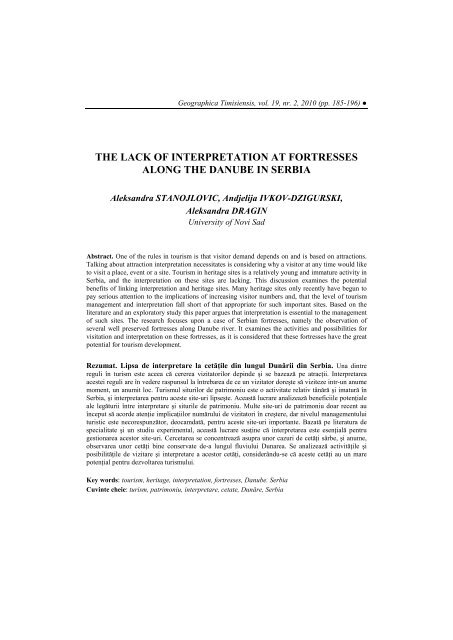
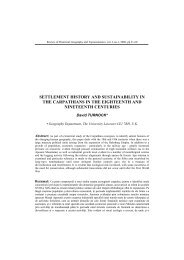
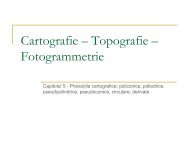
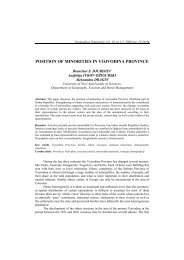
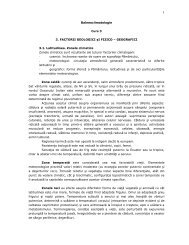
![in Romanian [pdf]](https://img.yumpu.com/51065862/1/184x260/in-romanian-pdf.jpg?quality=85)
